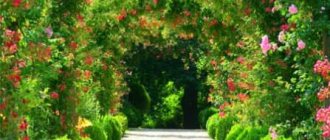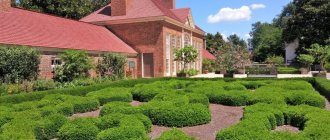In search of a Russian garden
Jorge Luis Borges wrote: “He who cultivates his garden, as Voltaire bequeathed <…>, saves the world one by one.” The 20th century proved that this is not just a beautiful metaphor. During the siege of Leningrad, employees of the half-destroyed local Botanical Garden of Peter the Great saved many city residents from starvation. They shared with Leningraders recipes for dishes made from plants that could be found in the gardens and parks of the Northern capital, and even created a real book of recipes, which included, for example, dandelion salad, nettle soup and casserole made from honey. Some of the garden's employees worked in the department of spore plants of the Botanical Institute. V.L. Komarova, where the first Soviet antibiotic, BINAN, was obtained from lichens: this is the sodium salt of usnic acid with high antibiotic properties.
Gardener Nikolai Kurnakov has worked in the Botanical Garden since 1902. During the war, he flatly refused to evacuate from the besieged city - he stayed for the sake of... a collection of cacti and succulents.
To save her from the bombings, he moved the plants to his apartment, covering literally everything with them except the bed. “I had to work with them like little children. The frostbitten parts of the plants rotted; by pruning, disinfecting, and sprinkling with crushed coal, we achieved healing of wounds,” said the scientist. The rescued plants returned to the Botanical Garden after the war, some have survived to this day - in memory of the blockade, St. George's ribbons were tied to them.
The garden has always meant a lot in Russia. We find mentions of him in the works of Russian writers and poets, memoirs of composers, history textbooks and books on culture. After the revolution, manor gardens were either destroyed or turned into city parks - such as Sparrow Hills Park, which grew out of three gardens at noble estates.
Today, landscape designers are trying to comprehend the phenomenon of the Russian garden: in September 2022, at the “In Search of the Russian Garden” festival at the Tsaritsyno Museum-Reserve, they were invited to recreate the gardens that once existed in Russia and reflect on the gardens of the future. Designers and gardeners presented their compositions - miniature gardens on several square meters.
For example, the Yasnaya Polyana garden has bushes of legendary roses that were grown by the women of the Tolstoy family: these flowers inspired their men to take long walks, during which ideas for literary works appeared. Tolstoy roses were not only grown, but also painted in watercolors: in memory of this, drawings protected by glass from rain and wind hang on the posts.
“Kulikovo Field” - birch trees, a wooden platform and a real river with a gilded bottom. The composition was created by designers Mila Rusakova and Mels Gevorgyan.
Olga Tikhomirova’s project is a garden at the Melikhovo estate, grown by Chekhov. It was he who became the prototype of the famous cherry orchard.
Olga recreated the white and gray porch of the legendary outbuilding “The Seagull”, where Chekhov wrote and hid from noisy guests, and the pillar with the bell that called the household for dinner, and the French vegetable garden - beds with useful apothecary herbs.
“Many people know that Chekhov was not only a writer and playwright, but also a doctor,” says Olga, “but not everyone knows that he was a keen gardener and builder.”
Why did gardens and parks inspire Russian writers, generals, officials and even emperors and empresses so much? What is a garden in general, how did it appear and change from century to century? And does modern man need a garden when there is a lot of entertainment besides walks in nature?
DIY gardens
Unlike gardens created by professional designers, “amateur” gardens are made from the heart and soul, which is why they are a true manifestation of national taste. I am absolutely convinced that they form the style of the national garden, since they are created by amateur experimenters.
Amateur gardens are the embodiment of the insatiable thirst for creativity of experimental gardeners
And this is by no means an insult, but an honorary title for those who, sparing no money and effort, “pass” a gigantic number of plants through their gardens and hearts. This reveals the people’s irrepressible energy, thirst for creativity and, in a good sense, disrespect for authority, without which the creation of something new is impossible.
"Transforming the world into an interior"
«„
“Sad” in Russian is a multi-valued word,” notes landscape designer Rostislav Grigoriev. “This is a huge park like Arkhangelsky, and a private summer cottage with flowers and trees, and greenhouses, and botanical gardens. Even the beds in the vegetable garden are a garden. The very definition in Russian culture is very vague.”
“I believe that a garden is born when its design is conceived,” says Mila Rusakova. “The garden matures and becomes fully realized in real life, when its concept can be read by an outside observer.”
We find similar words in “Poetry of Gardens” by Dmitry Sergeevich Likhachev:
“The garden is an attempt to create an ideal world of relationships between man and nature. Art is always an attempt by man to create some kind of happy environment. But if in other arts this environment is only partial, then in gardening it really surrounds
. This is the transformation of the world into a kind of interior. Therefore, in garden art, the material is not only trees, bushes and gardens, but also all other arts and partly nature outside the garden, for example, the sky, visible sometimes in large or small sizes through the trees and above the trees. A garden always expresses some philosophy, aesthetic ideas about the world, man’s relationship to nature; this is a microcosm in its ideal expression. “Like the gardener, so is the garden” - this saying of Tom Fuller dates back to 1732.
Features and purpose
It is better to see once than to hear a hundred times - this is the principle by which demonstration gardens are created.
Manufacturers understand that many gardeners are concerned about what else interesting to plant on their plot. And for this they need clear examples. Foreign manufacturers have been advertising various landscape solutions and plant varieties for a long time, illustrating them with the help of entire centers. This trend can also be seen in modern Russia.
Many nurseries are located near multidisciplinary garden centers. There is a trade in gardening tools and plants, various holidays and competitions are held, and children's leisure activities are organized. In this way, garden centers become hobby clubs.
The roots of heaven are in the East
Science finds it difficult to answer the question of where and when the first garden appeared, but religion readily does this. According to the Bible, the Garden of Eden, Eden, was the first place created on Earth. Its author and gardener was the Almighty. Eden was not located in heaven, as many believe, but in a specific place.
“From Eden came a river to water the garden; and then divided into four rivers. The name of one is Pison: it flows around the whole land of Havilah, where there is gold; and the gold of that land is good; there is bdellium and onyx stone. The name of the second river is Gihon [Geon]: it flows around the entire land of Cush. The name of the third river is Hiddekel [Tigris]: it flows before Assyria. The fourth river is the Euphrates."
Life 2:10–14
In other words, the divine garden was located on the territory of Mesopotamia, and this is not surprising: during the time of the Sumerian-Akkadian civilization, it was here that grandiose gardens appeared, the most famous of which are the Hanging Gardens in Babylon, one of the disappeared wonders of the world, the existence of which is still disputed.
According to legend, Queen Semiramis collected her favorite roses in these gardens all year round. Umberto Eco, in his book “The History of Illusions,” provides a detailed description of the Hanging Gardens, compiled by pseudo-Philo of Byzantium from the words of his contemporaries:
“The so-called hanging gardens grow above the ground and are cultivated in the air. The roots of trees hanging in the heights entwine the tiers of the earth. <….> on the rafters there is a thick layer of earth, where broad-leaved trees, most often grown in gardens, grow, a wide variety of flowers and everything that can please the eye and taste good. <….> The roots, which never dry out, draw strength from the water streams flowing nearby; The water also reaches the underground intertwining of roots, preserving the lushly grown trees. This is how they talk about the luxurious, regal, talentedly conceived and mostly artificial miracle of agriculture that hangs over the heads of those who contemplate it.”
Paradise in the minds of the Sumerians is the Garden of Dilmun, a kind of analogue of Eden, although inhabited exclusively by gods and forbidden to people. Despite the fact that both Dilmun and Eden are mythical gardens, the study of the history of the garden should begin with them. Likhachev emphasizes that the biblical paradise became a model for creating gardens for many centuries:
“So, the garden is paradise, but since there were fruit trees in paradise (the “tempter serpent” tempted Adam and Eve with an apple or grape), fruit trees are required in every garden. This applies equally to the Middle Ages, to the West and East of Europe, to the eras of the Renaissance and Baroque, Classicism and Romanticism.”
The second mandatory condition: the garden must constantly bloom and look as if eternal summer or eternal spring reigns in it. Likhachev in “The Poetry of Gardens” cites the instructions of the philosopher Francis Bacon on what flowers need to be planted in order to achieve this “year-round” effect: for example, in December holly, ivy, laurel, juniper “should be green”, in February - German camellia, crocus, primroses and anemones, in July - gillyflowers of all kinds, musk rose and fruit trees. Bacon notes that this instruction will create a ver perpetuum (“eternal spring”) even in the climatic conditions of London.
The concept of “heaven = garden” is reflected in Islam, which is why lush gardens have become so popular in the East. It was there that floriography appeared - the symbolic language of flowers, the existence of which became known in Europe thanks to the notes of Lady Mary Wortley Montagu, the wife of the British ambassador in Istanbul. In 1717 Lady Montagu wrote:
“There is no paint, no flower, no weed, no fruit, no grass, no stone, no bird's feather that does not have a verse corresponding to it, and you can quarrel, scold, send letters of passion, friendship, courtesy, or exchange news, without getting dirty. your fingers."
This language was loved by both the British and the French, and later by the Russians. In 1830, the book “Selam, or the Language of Flowers” by the poet Dmitry Oznobishin was published in St. Petersburg, in which about 400 meanings of plants were given. Floriography became an integral part of the works of Tolstoy, Turgenev, Aksakov and Chekhov. In all countries, the best place to learn this language was the garden.
Designer tips
How to preserve mature trees?
Proceed as carefully as possible: even if construction is underway, do not under any circumstances fill up the root collar - this will lead to the death of the tree.
Place paths next to trees in such a way as to bypass the projection of the crown: at this distance the main roots of the trees pass.
What plants are best planted in shady areas?
For planting in shady corners, ground cover, shade-tolerant perennials are suitable: fern, European hoofed grass, astilbe, pachysandra, periwinkle, variegated gooseberry, brunnera, tiarella, etc. So-called carpet plantings are suitable here.
If there is a small body of water on the site or there is a swampy part, you can plant Siberian and marsh irises, cattail, rush grass, reeds, and sedges there.
Powerful perennials, such as darmera, astilboides, rogersia, aruncus, can be planted in whole tracts.
! The main rule is not to arrange a lawn under mature trees, especially under pine and spruce trees.
How to competently approach planting large trees in a small area?
The tree will need space to grow and develop, so in a small area, large trees are usually planted like a tapeworm: on a lawn or clearing. But it will provide a lot of shade and can obscure crops growing nearby.
When planting, consider where the main paths and communications are. At least for the first few years, it is necessary to mulch and weed the tree trunk circle from weeds.
! Large trees should be purchased from a specialized nursery - such trees have a compactly formed root system that is not damaged during transplantation.
Photos in the material: Olga Petina, Larisa Yurova We thank the nursery of ornamental crops “Rozhdestveno” for their help in preparing the material. Interview knitted by Anna Prilipko
From monks to kings
In Europe, gardens also existed in ancient times: they were cultivated by both the Greeks and the Romans, and the Hellenes were the first to decorate garden spaces with sculptures, and the Romans were the first to create garden fountains. In the Middle Ages, gardens were filled with religious symbols - they were laid out mainly at monasteries, but they served not only as a place for thinking about God: medicinal plants and fruits that were used for food were grown there.
The first to develop the concept of a regular garden, back in the Renaissance, was the Italian architect Giacomo Vignola, who built the villa of Pope Julius III and laid out a garden with artificial ponds, stairs and passages. The garden becomes a symbol of luxury in the era of Baroque and Classicism - at a time when European people were still plagued by Plague, War, Famine and Death (sometimes all at once, sometimes in turn), the belief in the victory of reason over nature was strengthened. Speaking about the gardens of France, it is enough to mention the Versailles Park of the “Sun King” Louis XIV, whose author was the gardener Andre Le Nôtre. But before Versailles, Le Nôtre created an equally grandiose project - the Vaux-le-Vicomte garden for the royal minister Fouquet. Unfortunately, this masterpiece of landscape art brought Fouquet under the monastery. The king was outraged by the luxury of the garden; he asked where Fouquet got the money for such projects. The minister could not answer anything intelligible and went to jail, and the brilliant Le Nôtre went to serve the king to create Versailles.
The Parc Louis XIV becomes a repository for all types of arts: luxurious dinners are held here, operas are performed, and plays are staged. Diplomatic negotiations are held among copies of ancient sculptures, and ambassadors are received here. Jean-Baptiste Lully, the king's favorite composer, composes music especially for the garden. Gardens and parks of classicism and baroque become a delight for extroverts, albeit noble and rich extroverts.
Classicism and Baroque will be replaced by “sad romanticism”, and the garden will become like a wild forest, a hermit’s refuge: instead of trimmed sunny lawns there will be caves and shady grottoes, music will be replaced by birdsong and the splashing of water, and noisy amusements will be reflections on the rich inner world, life and death.
This will be the English garden, which will gain popularity all over the world. However, magnificent gardens created according to European models will appear in Russia earlier.
Lighting scenario
Lighting throughout the entire territory, including the forest area, is made in the same style. Not all lamps could fit into the forest theme, so special attention was paid to their selection. Tall lanterns are placed on the site, sconces are located near the house, and “two-headed” lamps are located in the entrance group.
In addition, there are lighting elements next to the birch trees near the retaining wall.
At one time, in order not to fill up the root collars of trees, wells were made around birch trees, inside which special lamps on pegs were installed. If necessary, they can be moved and the direction of the light flow changed.
Russian Garden - myth or reality?
Peter I began to actively adopt European experience, who ordered the garden at the Lefortovo estate (now a district of Moscow) to be remodeled in the Dutch manner: redevelopment, stairs and bridges to be built. It cannot be said that before Peter I there were no gardens in Russia - of course, they existed, but were not elevated to cult. Catherine I, succeeding Peter, built Arkhangelskoe, but in the traditions of classicism. Tsaritsyno Park absorbed features of both classicism and baroque, and the parks in Tsarskoe Selo - classicism and romanticism.
So what is a Russian garden? Does it even exist?
“Many people believe that Russian gardens are gardens at estates, for example Chekhov’s garden,” says Olga Tikhomirova. — In fact, Chekhov’s garden is a phenomenon that does not fit into the tradition of Russian estates. Chekhov bought Melikhovo and did not inherit it, as was customary in noble families. His love for cherries was incomprehensible to the Russian aristocracy. For example, Bunin: he didn’t like “The Cherry Orchard” and noticed that pure cherry orchards are bad manners, cherries have small, ugly flowers, and it’s somehow strange to compare great Russia with a flying cherry tree. A real Russian garden is Tsaritsyn’s “Pearl of the Baroque,” which was also presented at the exhibition “In Search of a Russian Garden.” This is a mixture of styles: here are bushes planted in the form of spirals - this technique was used in the Middle Ages on the territory of European monasteries - and evenly trimmed tree crowns, as in the era of classicism. Nearby are deliberately neglected trees that were allowed to grow naturally in the spirit of romanticism. Yes, mixing styles is what the Russian garden is based on.”
“The Russian garden is, first of all, an integral part of the Russian estate,” note landscape designers Anna Tarantina and Maria Selezneva. — Peter the Great really introduced the concept of a garden and, perhaps, even landscape design as such, but under the emperor there were many service people, and, as a rule, their estates were empty. They could afford to move to the estate and take care of the garden when they were already retired, and at that time they served for quite a long time. Only in the 18th century were the nobles released from military duty, and they hurried to their native places. Only from this moment on does the concept of “Russian garden” become concrete. Some estates were luxurious palaces with park ensembles, the models for which were the parks near St. Petersburg. Others are more suited to a relaxing country holiday. The location for the estate was carefully chosen: by the river or some picturesque location where a nobleman could calmly enjoy life, freed from the burden of secular ties. And, of course, we must not forget that the area of the noble estate was significant, and walks along it were long.
If you at your dacha give preference to the convenient location of paths and paths, coziness and comfort on the site, know: this all has something to do with the Russian garden. Its elements are a front flowerbed or rotunda, an alley of fruit trees, a small resting place with a bench in a secluded corner.
What makes the garden convenient and comfortable.”
“One of the features of the Russian garden is its utilitarianism,” agrees Vladislav Vorontsov, head of the memorial natural complex of the Leo Tolstoy museum-estate “Yasnaya Polyana”. — Alexander Blok said: “A garden without beds is a French park, not a Russian garden.” Another feature of the Russian garden is a combination of regularity and naturalness, a little neglect. In addition, plants and trees in Russian gardens and parks differ from European ones. We all know Bunin’s story “Dark Alleys”. So, dark alleys are a characteristic feature of the Russian estate park and garden. In the estates, linden trees were planted densely, forming dark corridors in which it was always cool. In the evenings, nightingales sang there, creating a romantic atmosphere. This is a Russian garden."
Cozy country landscape (video)
The large-scale landscape projects described in this article are not only the embodiment of the work and unleashing of the owner’s creative potential, but are also designed to attract visitors who will be able to choose and purchase the plants they like, get acquainted with new trends in landscape design and just have a good time.
The garden as the engine of Russian literature
Likhachev in “The Poetry of Gardens” suggests reading the garden as a text. This is no accident: the connection between the garden and literature is very strong. It is difficult to name all the writers who were influenced by garden art - one of them was Leo Tolstoy.
“We know about the long-standing culture of growing roses in Yasnaya Polyana from Leo Tolstoy’s mother, Maria Nikolaevna Volkonskaya, who in her manuscripts described the varieties of ancient roses that grew on the estate,” says Vladislav Vorontsov. “Rose hip beds are mentioned by Tolstoy in the stories “Blizzard” and “Dreams.”
“I’m going to the pond to my favorite place, between the rosehip flowerbed and the birch alley... <...> A gust of wind rustled the tops of the birches while still far from me; closer, I hear him stir the grass, and the leaves of the rosehip flowerbed began to sway, thrashing on their branches... <...> From the house, barking and looking back in bewilderment, Trezorka, Fyodor Filipich’s dog, runs down the mountain; but now his very figure, running from the mountain and shouting something, appears from behind a rosehip flowerbed.”
“I’m in the garden, in my late mother’s favorite place, near the pond... The moon... illuminates... the green banks... willow bushes and the dark green of the bushes... rose hips, densely grown together in flower beds scattered near the winding paths...”
"Dreams"
Rose hips have aesthetic merits and practical uses, which is typical for Russian gardens. From the point of view of the language of flowers, rosehip is spring and poetry.
A person who gives a rosehip flower admits that he is a romantic. Gardener Anton Denisovich Soans, who served with the Tolstoys from 1901 to 1919, described the Yasnaya Polyana flower beds as follows:
“At the back of the house there were flower beds, one oval and one round; one flowerbed was filled with roses, the other with heliotrope, geraniums, begonias, and large-flowered low terry petunias (but the Countess did not like petunias!). <…> The first and last flowerbed is oval. On the round ones there were often roses, and on the oval ones there were so-called low ones, for example: in the middle there was geranium or verbena and a border of low lobelia or viola, and on the round one there were roses. It happened that low roses were planted in oval flower beds, and tall standard roses were planted in round ones; one year before the count’s death, the roses in one flowerbed were very good - 2.5 arshins in height and the countess painted them all.”
The gardens had a great influence on the work of Alexander Blok, who for 36 years in a row, starting from his birth, spent the warm season on the estate of his grandfather, academician Andrei Nikolaevich Beketov. The wondrous nature of the Moscow region and village life set Blok in a romantic mood:
And the ringing door of the balcony opened into linden trees and lilacs, and into the blue dome of the sky, and into the laziness of the surrounding villages...
The Shakhmatovo estate with its garden became Blok’s spiritual homeland; more than 300 poems and the most important lyrical works were written there, including the cycle “Poems about a Beautiful Lady.”
Sergei Aksakov acquired the Abramtsevo estate in 1843. Here Aksakov got everything he wanted: marvelous nature, a river full of fish, forests and fields teeming with game, and, of course, a garden for walking. Moving to his estate became a new stage in life for Sergei Timofeevich; his best works were created in Abramtsevo.
“I think it is important to note the Dvoryaninovo estate and its owner Andrei Timofeevich Bolotov,” adds Vladislav, “who in 1786 wrote that “we need gardens, neither English nor French, but our own.” Bolotov is an outstanding and underrated personality; he made a great contribution to the recognition of tomatoes and potatoes as agricultural crops in Russia.”
Central Siberian Botanical Garden
This green corner in the Novosibirsk region is almost 70 years old. On the territory of the garden there are 12 scientific laboratories, coniferous and birch forests, and the Zyryanka River.
The garden's flora collection consists of 7,000 plant species, which are grouped into separate zones. This is how the rocky garden, the Bonsai Park, and the Garden of Continuous Flowering appeared. The best herbarium in the country is also located here, which consists of more than 500 thousand leaves and 1200 seeds.
The management plans to open a new exhibition consisting of cacti. Also, anyone can purchase seedlings for their plot.
“Show the children the trees!”
Today in large cities there is an increasing need for gardens and green spaces. This is emphasized by the creators of the exhibition “Moscow: Designing the Future,” which opened at the end of 2022 at the Museum of Moscow.
“I can say,” Moscow’s chief architect Sergei Kuznetsov noted at the opening of the exhibition, “that children and teenagers come to us and say: ‘We are not interested in technology. Trees! We are interested in trees, show us the trees.’”
Architects of Moscow and St. Petersburg show them: in the center of the capital, near the Kremlin, a few years ago the Zaryadye Park appeared, where not only flowers, but also wild herbs were planted. In one of the pavilions there is a “Florarium” greenhouse, in which more than 80 plants from all over Russia are cultivated without soil, using nutrient mixtures, including flax, wheat, and potatoes. In the Northern capital, on the island of New Holland, there is a herb garden. Next to it they sell books on botany, from which you can learn more about the seemingly inconspicuous herbs growing in this garden, and buy a souvenir badge in the form of a particular herb. It seems that gardens are becoming popular again, turning into art objects and fashion symbols.
“The place of the garden is everywhere,” says Mila Rusakova, “where there is minimal opportunity for this.
It could be a city, a suburb, a balcony, a yard well, an airport hall with a green area, anything. A garden has enormous value for a person of any era: interaction with a garden, especially regular and prolonged interaction, teaches people to slow down and calm down to a meditative state.
Try to choose some beautiful place: a garden, a dacha, just a beautiful landscape or park. Come there once a year to see how it changes and how the trees grow. Feeling every moment is what the garden gives us. The more you feel this place, the more clearly you will see every centimeter of growth. And you will feel how it changes you, how it calms and balances you. In a dynamic world, the ability to calm down is invaluable.”
According to research conducted in Philadelphia several years ago, green spaces and the mental health of city residents are directly linked. Converting vacant lots and industrial areas into green spaces helped combat depression and feelings of worthlessness, and led to a small but significant reduction in overall levels of poor mental health among subjects.
“The place of the garden is in the city,” notes Rostislav Grigoriev, “in addition to the impact on the human psyche, it is also excellent protection from noise and dust. The garden is a very environmentally friendly location, and the larger our cities and roads become, the more often we should remember this.”
It is necessary to preserve and revive the Russian garden in order to better understand Russian literature and art. So, having visited Melikhovo and seen the garden there with our own eyes, feeling its atmosphere, we understand why cherries became the central image of Chekhov’s play.
Having learned about the Tolstoys’ love for floristry, we will pay attention, for example, to Anna Karenina’s unusual dress, decorated with pansies. There is one Russian legend associated with these flowers: supposedly they grew on the grave of the girl Anna, who died of longing for her beloved.
The three-color petals are also symbolic: white - hope for happiness; yellow - surprise caused by the behavior of a loved one; purple - sadness and frustration. It seems like a small thing, but it shows the depth of the symbolism of Tolstoy’s language, his love for detail, and helps to feel the poetry of his prose.
According to landscape designers, the Russian garden is taking on new forms, absorbing new trends, but is not going to disappear anywhere.
“Now people have begun to think more and more about the past, and at the level of genetic memory,” say designers Anna Tarantina and Maria Selezneva. — Someone uses Internet resources and other sources to study their ancestry and learn more about their ancestors. And some intuitively use characteristic details in various aspects of their life, including the exterior of country houses. Today our customers choose Mediterranean and Scandinavian motifs, they want Japanese gardens, but each of them has a piece of the Russian garden. Details can appear at the stage of technical specifications or later, when the sketches are approved. We unconsciously but naturally recreate elements of something old, forgotten, but so dear.”
The most striking examples
The largest number of demonstration gardens are located in Poland. The largest private farms united more than 20 years ago into the Union of Nursery Growers. Despite this step, competition in the production of planting material in Poland is still very high.
The most popular garden complex is KAPIAS, located in the south of Poland, near the city of Katowice. The founder of the idea is Bronislav Kapias. It was he who first decided to attract buyers with the help of demonstration gardens. So, on an area of 40 acres, gardens were grown, which are now called “Old”. According to the author's idea, they became a series of successive garden rooms, made in different styles.
In the “Old Gardens” you can see a small and cozy “oriental” garden. The surface of the earth here is covered with gravel. The garden itself is surrounded by a wall made of stone and screens made of bamboo.
Here you can see other elements of the Japanese style: fan maples, bonsai, bridge.
There is a patio area with a table and chairs made from tree stumps. Guests can also sit in various gazebos and pavilions, look at the rock garden, climb onto the bridge and feed the fish. Amazingly beautiful flowers are planted in a romantic corner.
We recommend that you read the article about the most beautiful flowers in the world.
In 2008, Old Gardens was expanded. The new demonstration projects now span almost 4.5 hectares. There are playgrounds, a restaurant, a lake, walking paths, and 20 gardens of various themes. The most original is the corner, made in the national colors of the Polish flag. Roses and barberries are combined with birches, lobelias, hydrangeas, and sedums.
The highest point of the complex is considered to be a terrace, and there is also a bridge located here. From here you can see all the beauties of the gardens.
Sochi Arboretum
The picturesque garden and park ensemble, created at the end of the 19th century by the publisher of the Petersburg Newspaper Sergei Khudekov, is an excellent place for relaxation and walks, as well as a popular attraction for guests of Sochi. Each part of the Sochi Arboretum, cut in half by Kurortny Prospekt, is decorated in its own style. The central one, recreating the green areas of sunny Italy, is full of exquisite decorative elements, carved gazebos and sculptures describing scenes from myths. The main part of the botanical garden is a real English park, emphasizing the natural beauty of wildlife.
Summer always reigns on the territory of the arboretum. Peacocks stroll leisurely here, ducks, swans and even pelicans swim along the picturesque overgrown lakes, and ostriches live in the northwest. Every 15 minutes, cable car cars run between the Upper and Lower Parks, making it easier to move around the magnificent realm of peace and quiet in the heart of bustling Sochi.
1311 accommodation options in Sochi











